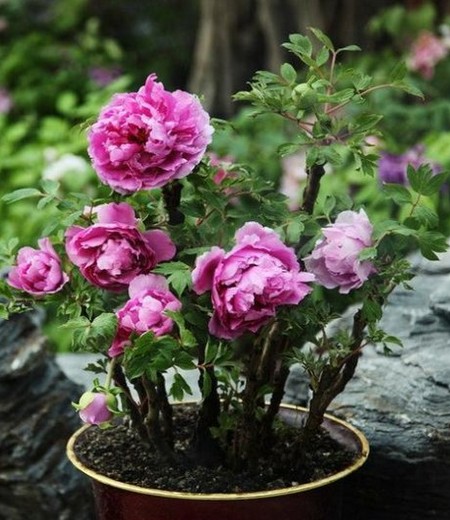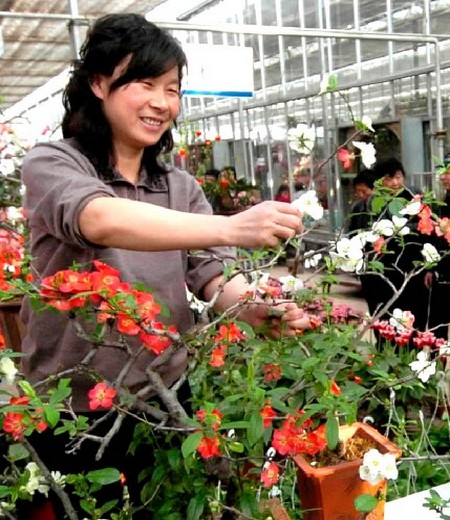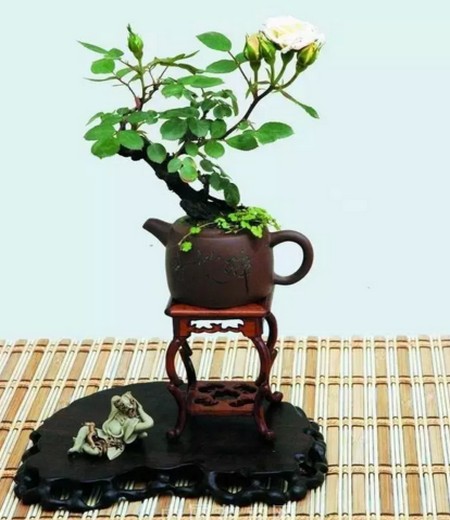The making method of peony bonsai
Peony bonsai is a new kind of bonsai, which combines magnificent peony with simple and elegant bonsai art to form an art form with unique Central Plains style, which is praised by bonsai experts and scholars in our country. The following introduces the method of making peony bonsai:

Variety selection:
The requirements of peony bonsai varieties are relatively strict, and the varieties with higher flowering rate, moderate growth and easy shape should be selected. Such as "cinnabar base", "Zhao Fan", "Hu Hong", "Azure Dragon lying ink pool", "fat red" and other varieties. In addition, although the number of flowers is small and the growth is large, Shengdan stove has strong growth, vigorous branches and good natural plant type, so it is suitable to be used as bonsai material.
Stump selection:
In the selection of peony stump, from the point of view of rapid prototyping, we should choose the stump which is suitable for modeling or trunk simple and dignified, and the seedling age is older. The one with good natural pile view is the most ideal.
Potted soil preparation:
Peony is a deep-rooted flower, fleshy root, less fibrous root, but as a bonsai, the volume of the basin is limited, which results in a relative reduction of root nutritional area, resulting in malnutrition between underground and aboveground parts, thus affecting the normal growth and development of peony. Therefore, the scientific preparation of cultivated soil is very important. According to the characteristics of peony, the cultivated soil should be loose and fertile, with high humus content and long-lasting fertilizer effect. According to our research, the ideal formula is humus, horse dung, garden soil and slag mixed evenly according to the ratio of 2 to 1, and sealed with human feces and urine, and then reused one month later.
Potting time:
The time of potting directly affects the root development of Zhuanjing and the normal flowering in the coming year. Practice has proved that it is more suitable to start the basin in the middle and last ten days of September.
Modeling method:
The wood of peony is brittle and easy to break, so it is difficult to process.
Bend the ① trunk and let it be as natural as possible. When tilting planting on the basin, first wrap the bending part with a setting rope or brown skin, and then insert a corresponding thickness of wire from the base (12Muth18) for 45 °oblique winding in the same direction as the predetermined twist, so that it can be wound more and more tightly. Or use hemp rope for bow traction, operate by stages, bend step by step, and gradually achieve the goal of modeling.
② branching (twig) treatment is mainly pruning. The level of pile scene and the leaving of branches and buds should be considered, such as density, virtual-real relationship and spatial layout, so as to achieve the ideal effect.
③ root treatment: root exposure can be balanced with the crown center of gravity, echoing up and down, so that the root, such as tiger paw, eagle claw, full of force. The method of gradually scouring the basin soil can be used for root exposure treatment, and the root can be raised year by year. The hypertrophy of peony leaves can be controlled by controlling water and fertilizer and spraying dwarf.
Pot surface treatment (with stone and cloth moss):
The best stone is Taihu stone and stalagmite, which can lie and stand, and pay attention to the harmony and balance of the whole work. Cloth moss can increase the beauty of the work and have the effect of moisturizing and heat insulation.
Time: 2019-05-26 Click:
- Prev

Cultivation and production techniques of Plum Blossom Bonsai
Making bonsai of plum blossoms is an art and a kind of culture. Countless predecessors have studied continuously to form today's plum blossom culture. Learning and summarizing these cultures is a responsibility and obligation of our generation, especially those who love plum blossoms.
- Next

Technical points of bonsai production of rose
Rose is a promising bonsai material. The combination of rose and bonsai has not only the natural beauty of bonsai, but also the beauty of rose. A well-made and vivid rose bonsai is a very infectious work of art. Rose is known as the queen of flowers because of its colorful and graceful appearance.
Related
- Fuxing push coffee new agricultural production and marketing class: lack of small-scale processing plants
- Jujube rice field leisure farm deep ploughing Yilan for five years to create a space for organic food and play
- Nongyu Farm-A trial of organic papaya for brave women with advanced technology
- Four points for attention in the prevention and control of diseases and insect pests of edible fungi
- How to add nutrient solution to Edible Fungi
- Is there any good way to control edible fungus mites?
- Open Inoculation Technology of Edible Fungi
- Is there any clever way to use fertilizer for edible fungus in winter?
- What agents are used to kill the pathogens of edible fungi in the mushroom shed?
- Rapid drying of Edible Fungi

